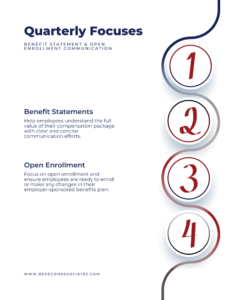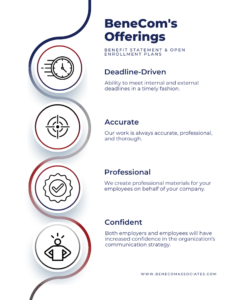Benefits communication refers to the process of sharing information with employees about the benefits package offered by their employer. This includes health insurance, retirement plans, vacation time, sick leave, and other perks or programs.
Effective benefits communication aims to ensure that employees understand their options and the value of their benefits, which can increase engagement, retention, and overall job satisfaction. Communication methods may include print, newsletters, posters, one-on-one meetings, digital media, online portals, and more. A clear and transparent communication strategy can help employers attract and retain top talent while also promoting employee well-being.

Although the benefits enrollment process does not last year round, communication around these important topics should. Developing a long-term communication plan can ensure your employees are fully educated on various concepts. It also leaves employees plenty of time to ask questions and find the programs and plans that best fit their needs. Happy, engaged, and knowledgeable employees will use their benefits more than dissatisfied workers, creating an improved return on investment for the organization. Everyone wins in this scenario.
HR managers should develop a detailed communication calendar to consistently provide employees with valuable resources throughout the year. This calendar can feature a variety of HR initiatives including quarterly themes, important dates, fiscal year considerations, enrollment periods, company initiatives, and employee goals.
As the main stakeholder, employees are put at the forefront of benefits communication. Outside of employees, there is a variety of people who might play a role or hold responsibility in communication efforts.
Internal responsibility for successful enrollment can fall on the shoulders of HR teams, benefits professionals, and other managers. Brokers and consultants can also be a part of the process, serving their clients and tackling important communication challenges.
No matter who is in charge, outlining a detailed plan and using the right communication partner will help stakeholders deliver a quality project.

To actively engage and shape an employee’s understanding and actions, companies must deliver customized, easily accessible communications that cater to their organization.
From an email newsletter to a visual calendar to a printed benefits booklet, there are numerous ways to improve employee communication surrounding benefit options. The best practices for benefits communication depends on the unique needs of your company and the preferences of your employees.
Digital media is one of the most popular and effective avenues for engaging employees in important HR topics. Digital media can be utilized in different ways including a website dedicated to employee benefits, social media platforms, engaging blog posts, and even mobile apps that send push notifications to employees. These are all compelling strategies to stay in touch with full-time and part-time employees who rely on this information to take advantage of things like holiday pay, health insurance, retirement savings, and other important benefits.
Other influential communication techniques include sending out regular email newsletters, utilizing text messages, and distributing print media.
Every organization will have a unique annual cycle for its benefit statement and open enrollment plan, so the exact timeline will vary. Generally, BeneCom Associates recommends segmenting the calendar year to separately address both benefit statements and open enrollment.

With a segmented communication plan, the first and last quarters can focus on benefit statements including various types of programs and benefits an employee is eligible for, such as health insurance, retirement plans, life insurance, disability insurance, and more. They may also include information about paid time off, bonuses, and other forms of compensation.
Focusing a set time period on benefits statements and benefits communication can help employees understand the full value of their compensation package, beyond just their salary or hourly wage. By providing employees with a clear and concise summary of their benefits and compensation, employers can increase employee appreciation for their compensation and help employees make more informed decisions about their benefits.
With updated and accurate knowledge of their current benefits, employers can move on to quarters two and three, focusing on the open enrollment period and ensuring employees are ready to enroll or make any changes in their employer-sponsored benefits plan.
Communication during these times will prioritize helping employees carefully review their plans and ensuring that they are making the most informed decisions for their personal and family needs.
Again, the exact timeline for your organization’s communication plan will vary, but setting aside time to highlight both benefit statements and open enrollment is the main idea.
Outside of benefits statements and open enrollment, the HR communications team should commit to making information sessions, websites, and other valuable resources available to employees throughout the calendar year.

Many HR initiatives come out of an organization’s annual performance review period. Aligning your overall communication strategy around performance reviews and using them to better understand your current communication challenges can help inform your benefits communication strategy and make improvements to the organization as a whole.
Retirement planning can be a complex topic, but it can also be an exciting one when employees understand how much of a difference it makes to set aside a small percentage of each paycheck. This is especially true when the employer provides a full or partial match to the employee’s contribution.
Maintaining financial literacy is helpful for employees and can cover a variety of topics such as managing credit and debt, obtaining a credit report, and saving for a down payment on a house. Outlining the financial benefits of the company’s compensation package will help employees feel excited about them and encourage them to consistently use financial resources to their benefit.
Sharing a Health Awareness Calendar that focuses on a specific condition every month is a great way to help employees become more informed about health screening and caring for their own health. The campaign could also include posters and emails about certain health topics while encouraging people to take advantage of opportunities already available to them, such as COVID-19 booster shots.
True wellness is not only the absence of sickness but a feeling of positive well-being in both mind and body. Wellness benefits for employees should go beyond just providing health insurance. Communicating and encouraging employees to practice wellness in their lifestyle will create more productive and healthier workers.
When pulling together a new communication strategy about employee benefits, remember that the goal is to get people excited about the benefits available without making them feel overwhelmed. Communication should come in bite-sized pieces through diverse channels that utilize interactive elements.
For example, HR might send an email letting people know that this year’s benefits package has changed without going into too much detail about what those changes are and how to make them. The idea is to make people aware months ahead of time, so they feel prepared to ask questions when the annual open enrollment period does arrive.
At BeneCom Associates, we feel passionate about communicating benefits in unique, interactive ways. We offer customized communication solutions to ensure that your company meets its benefits objective on time and stays within budget for the entire year.

Are you ready to work with a more reliable benefits partner? BeneCom stays on message from start to finish, and we won’t break your current budget in any of these areas. We also form strategic partnerships with brokers and consultants.
Getting your employees to engage with benefits information regularly isn’t an overwhelming task, but it does require a commitment of time and resources for the best results and return on investment. We encourage you to contact us, we’d love to hear more about your company and your unique benefits communication needs.